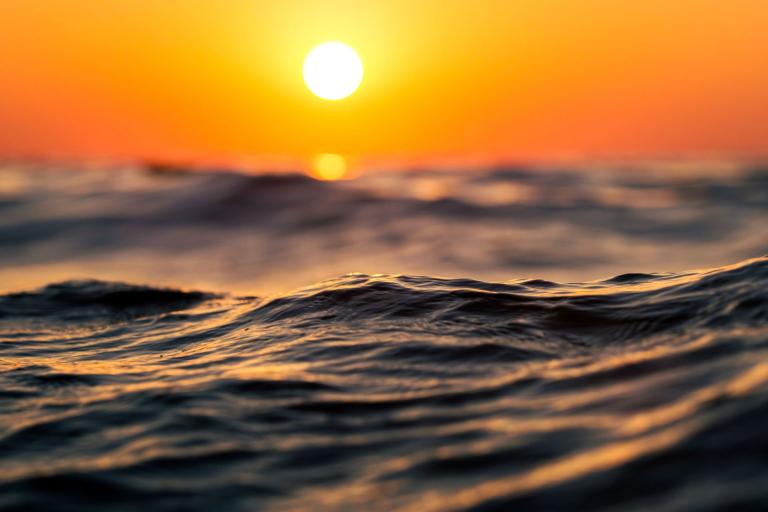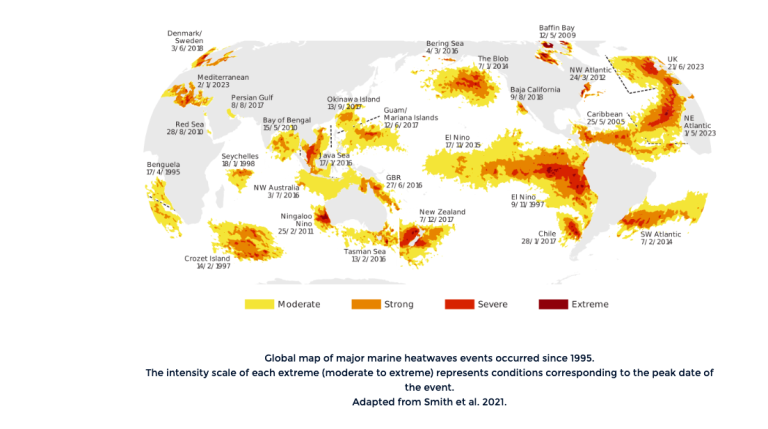Report card gives update on the Global Ocean Observing System

The Global Ocean Observing System (GOOS) has just published its annual Report Card on the status of observing networks and how they meet urgent societal needs, including tracking marine heatwaves, advancing safety of life at sea, and protecting seagrass ecosystems.
Although there is continuing progress in systematically monitoring and understanding the ocean, high-impact events such as tropical cyclones, marine heatwaves, and extreme marine weather mean there is a need for an ever-increasing range of ocean services, it says.
The Ocean Observing System Report Card devotes a special chapter to marine heatwaves. Often extending deep below the sea surface, marine heatwaves have disastrous effects on marine ecosystems, including shifts in locations of fish, and high mortality rates of vulnerable species.
They also influence other extreme events on land, such as droughts and heatwaves, and the rapid intensification of tropical cyclones.
“Due to climate change, marine heatwaves are becoming more frequent, more intense and lasting longer. They now occur in all ocean basins, putting an array of ocean ecosystems and communities at risk,” says the Report Card.
In 2022, despite the occurrence of La Niña - a climatic phenomenon characterized by cooler-than-normal global mean sea surface temperatures, 58% of the ocean surface suffered at least one marine heatwave event. The development of El Niño, with warmer-than-normal sea surface temperatures in the Pacific, means that it is likely that 2023-2024 will witness even more intense marine heatwaves. This was evidenced by a northeastern Atlantic heatwave in June 2023.
Different international programmes such as GOOS, the World Climate Research Programme, and the Global Climate Observing System are now working in synergy to develop a comprehensive set of observations, integrating satellite and in situ observations,” to address marine heatwaves impacts. This involves working with national and international stakeholders, such as managers of marine ecosystems and fisheries.
In the face of climate change, the global communitymust work together to improve the coverage, quality, and multidisciplinary nature of the observing system to meet vital forecasting services and societal needs. OceanOPS can help make these connections,” says Mathieu Belbéoch, Manager of OceanOPS, which is the international hub that provides vital services in monitoring, integrating and supporting the operations and data flows of the GOOS networks.

Eyes on the Ocean
The Global Ocean Observing System unites international, regional and national ocean observing programmes, governments, UN agencies, research organizations and individual scientists to monitor our changing ocean through the ‘eyes’ of thousands of ocean observing platforms. These platforms range from autonomous profiling floats and underwater gliders, to fixed and drifting buoys, to commercial and research ships, and even marine mammals.
This network has recovered from the impact of COVID-19 on observing operations. There have also been significant advances in technology, autonomous instruments, multidisciplinary approaches, and in international collaboration, says the Report Card.
It showcases achievements and challenges in continuing to integrate physical, biogeochemical and biological observations.
There is growing investment in biogeochemical sensors and deep autonomous Argo profiling floats, and an increase in emerging components of the system like smart cables and Unmanned Surface Vehicles continued to develop, in part due to strong collaboration with private sector partners.
Safety of Life at Sea
To ensure timely and accurate metocean warnings and forecasts requires a robust linkage from marine observations to data processing, forecast models, and services. The World Meteorological Organization (WMO) and the Intergovernmental Oceanographic Commission of UNESCO work together through GOOS to connect the links in this chain.
1,600 ships provide nearly 10,000 observations per day, sharing them in real-time through the WMO Global Telecommunications System.
Despite recent gains in forecast skill, ships still sustain weather-related damage, with cargo, vessels and lives continuing to be lost at sea. GOOS is currently engaging with the shipping community to expand metocean observations from all vessels at sea, for the benefit of services to the mariner. The value of metocean observations cannot be overstated, particularly in under-sampled areas such as the higher latitudes. More quality observations, taken more often, will improve forecasts for all vessels at sea. Weather related losses at sea must be reduced. To do so requires “all hands on deck” from ships’ crews to forecasters, to collect better data, improve forecasts, and enhance maritime safety.
“GOOS has never been better positioned to usher in a new era of ocean information: new observing technologies, and private sector engagement are presenting new opportunities for GOOS to address these and other urgent ocean observing needs,” says David Legler, Chair of the GOOS Observations Coordination Group.
The Report Card is produced by OceanOPS - the operational monitoring and support center for GOOS. GOOS is a programme led by the Intergovernmental Oceanographic Commission (IOC) of UNESCO, with the World Meteorological Organization (WMO), UN Environmental Programme (UNEP) and the International Science Council (ISC).
The online version of the 2023 Ocean Observing System Report Card is available at: ocean-ops.org/reportcard and in pdf.










